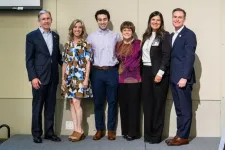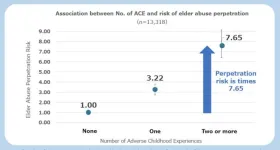(Press-News.org) As Mark Hasegawa-Johnson combed through data from his latest project, he was pleasantly surprised to uncover a recipe for Eggs Florentine. Sifting through hundreds of hours of recorded speech will unearth a treasure or two, he said.
Hasegawa-Johnson leads the Speech Accessibility Project, an initiative at the University of Illinois Urbana-Champaign to make voice recognition devices more useful for people with speech disabilities.
In the project’s first published study, researchers asked an automatic speech recognizer to listen to 151 hours — almost six-and-a-half days — of recordings from people with speech disabilities related to Parkinson’s disease. Their model transcribed a new dataset of similar recordings with 30% more accuracy than a control model that had not listened to people with Parkinson’s disease.
This study appears in the Journal of Speech, Language, and Hearing Research. The speech recordings used in the study are freely available to researchers, nonprofits and companies looking to improve their voice recognition devices.
“Our results suggest that a large database of atypical speech can significantly improve speech technology for people with disabilities,” said Hasegawa-Johnson, a professor of electrical and computer engineering at Illinois and a researcher at the university’s Beckman Institute for Advanced Science and Technology, where the project is housed. “I look forward to seeing how other organizations will use this data to make voice recognition devices more inclusive.”
Machines like smartphones and virtual assistants use automatic speech recognition to make meaning from vocalizations, allowing people to queue up a playlist, dictate hands-free messages, seamlessly participate in virtual meetings and communicate clearly with friends and family members.
Voice recognition technology does not work well for everyone; in particular, those with neuromotor disorders like Parkinson's disease that can cause a range of strained, slurred or discoordinated speech patterns, collectively called dysarthria.
“Unfortunately, this means that many people who need voice-controlled devices the most may encounter the most difficulty in using them well,” Hasegawa-Johnson said.
“We know from existing research that if you train an ASR on someone’s voice, it will begin to understand them more accurately. We asked: can you train an automatic speech recognizer to understand people with dysarthria from Parkinson’s by exposing it to a small group of people with similar speech patterns?”
Hasegawa-Johnson and his colleagues recruited about 250 adults with varying degrees of dysarthria related to Parkinson’s disease. Prior to joining the study, prospective participants met with a speech-language pathologist who evaluated their eligibility.
“Many people who have struggled with a communication disorder for a long time, especially a progressive one, may withdraw from daily communication,” said Clarion Mendes, a speech-language pathologist on the team. “They might share their unique thoughts, needs and ideas less and less often, thinking their communication is just too impacted to engage in meaningful conversations.
“Those are the exact people we’re looking for,” she said.
Selected participants used their personal computers and smartphones to submit voice recordings. Working at their own pace and with optional assistance from a caregiver, they repeated well-worn vocal commands like “Set an alarm,” recited passages from novels and opined on open-ended prompts like “Please explain the steps to making breakfast for four people.”
Responding to the latter, one participant enumerated the steps to make Eggs Florentine — Hollandaise sauce and all — while another pragmatically advised to order takeout.
“We’ve heard from many participants who have said that the participation process was not only enjoyable, but that it gave them the confidence to communicate with their families again,” Mendes said. “This project has brought hope, excitement and energy — uniquely human qualities — to many of our participants and their loved ones.”
She said the team consulted with Parkinson’s disease experts and community members to develop content relevant to participants’ lives. Prompts were specific and spontaneous: training a speech algorithm to recognize medication names, for example, may help an end user communicate with their pharmacy, while casual conversation-starters mimic the cadence of daily chit-chat.
“We tell participants: We know that you can make your speech clearer by putting all your effort into it, but you’re probably tired of having to try to make yourself understood for the benefit of others. Try to relax and communicate as if you’re chatting with your family on the couch,” Mendes said.
To gauge how well the speech algorithm listened and learned, the researchers divided the samples into three sets. The first set of 190 participants, or 151 recorded hours, trained the model. As its performance improved, the researchers confirmed that the model was learning in earnest (and not just memorizing participants’ responses) by introducing it to a second, smaller set of recordings. When the model reached peak performance on the second set, the researchers challenged it with the test set.
Members of the research team manually transcribed an average of 400 recordings per participant to check the model’s work.
They found that after listening to the training set, the ASR system transcribed recordings from the test set with a word error rate of 23.69%. For comparison, a system trained on speech samples from people without Parkinson’s disease transcribed the test set with a word error rate of 36.3% — roughly 30% less accurate.
Error rates also decreased for almost all individuals in the test set. Even speakers with less typical Parkinsonian speech, like unusually fast speech or stuttering, experienced modest improvements.
“I was excited to see such a dramatic benefit,” Hasegawa-Johnson said.
He added that his enthusiasm is bolstered by participant feedback:
“I spoke with a participant who was interested in the future of this technology,” he said. “That’s the wonderful thing about this project: seeing how excited people can be about the possibility that their smart speakers and their cell phones will understand them. That’s really what we're trying to do.”
Editor's notes:
The publication titled “Community-supported shared infrastructure in support of speech accessibility” is accessible online at https://doi.org/10.1044/2024_JSLHR-24-00122.
Please consult the publication for full author information.
Research described in this press release is supported by Amazon, Apple, Google, Meta and Microsoft; the National Institute on Deafness and Other Communication Disorders of the National Institutes of Health under award no. R13DC003383; and the National Science Foundation under award no. 1725729.
The content is solely the responsibility of the authors and does not necessarily represent the official views of the National Institutes of Health.
Reach Mark Hasegawa-Johnson at jhasegaw@illinois.edu
About the Speech Accessibility Project
The Speech Accessibility Project is a research initiative to make voice recognition technology more useful for people with a range of diverse speech patterns and disabilities. The project is housed within the University of Illinois Urbana-Champaign’s Beckman Institute for Advanced Science and Technology and was announced in fall 2022. Currently, the project is recruiting English-speaking U.S. and Canadian adults who have Parkinson’s disease, Down syndrome, cerebral palsy, amyotrophic lateral sclerosis and those who have had a stroke. The project has unprecedented cross-industry support from funders Amazon, Apple, Google, Meta and Microsoft, as well as nonprofit organizations whose communities will benefit from this accessibility initiative. As of the end of June 2024, the project has shared 235,000 speech samples with the five funding companies. Apply to join the Speech Accessibility Project.
Conduct research through the Speech Accessibility Project
The Speech Accessibility Project has released approximately 170 hours of speech recordings and annotations from 211 participants with Parkinson’s disease (comprising the training and development datasets). The project is accepting proposals for researchers, companies and nonprofits that want to use the recordings and annotations to make technology accessible to all. Submit a proposal to conduct research through the project.
About the Beckman Institute
The Beckman Institute for Advanced Science and Technology is an interdisciplinary research institute on the University of Illinois Urbana-Champaign campus. It is home to nearly 200 faculty members, 400 grad students and 90 postdocs. Its researchers tackle topics like intelligence, molecules and imaging. The result: scientific advances that couldn’t occur any other way.
END
Automatic speech recognition learned to understand people with Parkinson’s disease — by listening to them
Listening to people with Parkinson’s disease made an automatic speech recognizer 30% more accurate, according to initial findings from the Speech Accessibility Project.
2024-09-27
ELSE PRESS RELEASES FROM THIS DATE:
Addressing global water security challenges: New study reveals investment opportunities and readiness levels
2024-09-27
NEW YORK, September 27, 2024 – Water scarcity, pollution, and the burden of waterborne diseases are urgent issues threatening global health and security. A recently published study in the journal Global Environmental Change highlights the pressing need for innovative economic strategies to bolster water security investments, focusing on the “enabling environment” that influences regional readiness for new business solutions.
Initiated and led by researchers at the Advanced Science Research Center at the CUNY Graduate Center (CUNY ASRC), ...
Commonly used drug could transform treatment of rare muscle disorder
2024-09-27
The study, published in Lancet Neurology, detailed the “head-to-head” trial implemented by the researchers to test two drugs, mexiletine and lamotrigine, on people with the condition.
The trial, which was conducted at the UCL Queen Square Multidisciplinary Centre for Neuromuscular Diseases and the National Hospital for Neurology and Neurosurgery, UCLH, involved 60 adults with confirmed non-dystrophic myotonia.
Patients were randomly assigned to receive either mexiletine for eight weeks followed by lamotrigine for eight weeks, or the reverse order, with a seven-day ...
Michael Frumovitz, M.D., posthumously honored with Julie and Ben Rogers Award for Excellence
2024-09-27
HOUSTON ― The University of Texas MD Anderson Cancer Center has posthumously awarded Michael Frumovitz, M.D., with the Julie and Ben Rogers Award for Excellence in Patient Care. The annual award recognizes employees who consistently demonstrate excellence in their work and dedication to MD Anderson’s mission to end cancer. The award’s focus rotates among the areas of patient care, research, education, prevention and administration, with this year’s award focusing on patient care.
Frumovitz dedicated more than 20 years of service to MD Anderson, most recently as chief patient experience officer and professor in Gynecologic ...
NIH grant supports research to discover better treatments for heart failure
2024-09-27
A University of Arizona College of Medicine – Phoenix researcher was recently awarded a $1.9 million National Institutes of Health grant to study the molecular mechanisms of how dilated cardiomyopathy progresses to heart failure, which could eventually lead to better preventive and treatment options for heart failure.
Heart failure is inextricably linked with dilated cardiomyopathy, or DCM, a disease characterized by the progressive enlargement of the heart and reduced contractility reflected by reduced ejection fraction. ...
Clinical cancer research in the US is increasingly dominated by pharmaceutical industry sponsors, study finds
2024-09-27
Clinical cancer research in the U.S. is increasingly dominated by pharmaceutical industry sponsors, study finds
Study underscores need for increased investment in federally funded cancer clinical trials
SEATTLE – September 27, 2024 – Researchers at Fred Hutch Cancer Center identified a substantial increase over the past decade in the proportion of patients with cancer in the U.S. who participate in pharmaceutical industry sponsored clinical trials compared to those conducted with federal government support. Published in The Journal of Clinical Oncology and presented at the ASCO Quality Care Symposium, these findings reveal trends of underinvestment in federally ...
Discovery of 3,775-year-old preserved log supports ‘wood vaulting’ as a climate solution
2024-09-27
A new study published in the journal Science suggests that an ordinary old log could help refine strategies to tackle climate change.
A team of researchers led by University of Maryland Atmospheric and Oceanic Science Professor Ning Zeng analyzed a 3,775-year-old log and the soil it was excavated from. Their analysis, published on September 27, 2024, revealed that the log had lost less than 5% carbon dioxide from its original state thanks to the low-permeability clay soil that covered it.
“The wood is nice and solid—you could probably make a piece of furniture out of it,” Zeng noted.
Understanding the ...
Preterm births are on the rise, with ongoing racial and economic gaps
2024-09-27
Preterm births have increased by more than 10 percent over the past decade, with racial and socioeconomic disparities persisting over time, according to a new study analyzing more than five million births.
The study, published in the journal JAMA Network Open, also found that some factors that increase the risk for preterm birth—such as diabetes, sexually transmitted infections, and mental health conditions—became much more common over the past decade, while other factors that protect against preterm birth declined.
“Our findings not only show that preterm births are on the rise, but provide clues as ...
Menopausal hormone therapy use among postmenopausal women
2024-09-27
About The Study: The results of this cross-sectional study show that over the past 2 decades, menopausal hormone therapy use declined among U.S. postmenopausal women of all age and racial and ethnic groups. Women of racial and ethnic minority groups had lower prevalence of menopausal hormone therapy use compared to non-Hispanic white women.
Corresponding Authors: To contact the corresponding authors, email Lin Yang, PhD, (lin.yang@ahs.ca) and Adetunji T. Toriola, MD, PhD, MPH, (a.toriola@wustl.edu).
To access the embargoed study: Visit our For The Media website at this link https://media.jamanetwork.com/
(doi:10.1001/jamahealthforum.2024.3128)
Editor’s ...
Breaking the chain of intergenerational violence
2024-09-27
New research shows the connection between adverse childhood experiences (ACEs), such as physical or emotional abuse, and an increased risk of people growing up to be abusive against older generations. While generational trauma is known to be passed down from parent to child, the study showed that it can also reverberate upwards from parent to older generations. A survey of over 13,000 people in Japan found that about half had one or more ACEs. Of these, 8.5% self-reported committing some form of physical or verbal abuse against people aged over 65. An important contributing factor was the person’s mental and physical health, both of which are known to be affected by ...
Unraveling the role of macrophages in regulating inflammatory lipids during acute kidney injury
2024-09-27
Tsukuba, Japan—Acute kidney injury (AKI) is associated with a poor prognosis, and no effective treatment has been established to date. Understanding the mechanisms that prevent the progression of AKI is crucial. In AKI, immune cells known as macrophages produce lipid mediators (LMs), which are lipids with significant physiological activity and play a pivotal role in promoting and suppressing inflammation. Thus, elucidating their function is of paramount importance.
In this study, researchers focused ...
LAST 30 PRESS RELEASES:
American College of Cardiology comments on new dietary guidelines for Americans
American Society of Gene & Cell Therapy and Orphan Therapeutics Accelerator partner to advance and commercialize promising rare disease treatments
One in 14 patients having day case surgery have new or worse chronic pain 3 months after their operation
New study highlights link between eviction rates and gun violence
Heatwaves heat up soil but not toxin levels in rice, study finds
Digital modeling reveals where construction carbon emissions really come from
Turning farm waste into water filters
New study shows how the spleen helps the immune system accept a transplant
New Mayo Clinic study advances personalized prostate cancer education with an EHR-integrated AI agent
Researchers identify novel therapeutic target to improve recovery after nerve injury
Microbes in breast milk help populate infant gut microbiomes
Reprogramming immunity to rewrite the story of Type 1 diabetes
New tool narrows the search for ideal material structures
Artificial saliva containing sugarcane protein helps protect the teeth of patients with head and neck cancer
Understanding the role of linear ubiquitination in T-tubule biogenesis
Researchers identify urban atmosphere as primary reservoir of microplastics
World’s oldest arrow poison – 60,000-year-old traces reveal early advanced hunting techniques
Bristol scientists discover early sponges were soft
New study uncovers how rice viruses manipulate plant defenses to protect insect vectors
NSF–DOE Vera C. Rubin Observatory spots record-breaking asteroid in pre-survey observations
Ribosomal engineering creates “super-probiotic” bacteria
This self-powered eye tracker harnesses energy from blinking and is as comfortable as everyday glasses
Adverse prenatal exposures linked to higher rates of mental health issues, brain changes in adolescents
Restoring mitochondria shows promise for treating chronic nerve pain
Nature study identifies a molecular switch that controls transitions between single-celled and multicellular forms
USU chemists' CRISPR discovery could lead to single diagnostic test for COVID, flu, RSV
Early hominins from Morocco reveal an African lineage near the root of Homo sapiens
Small chimps, big risks: What chimps show us about our own behavior
We finally know how the most common types of planets are created
Thirty-year risk of cardiovascular disease among healthy women according to clinical thresholds of lipoprotein(a)
[Press-News.org] Automatic speech recognition learned to understand people with Parkinson’s disease — by listening to themListening to people with Parkinson’s disease made an automatic speech recognizer 30% more accurate, according to initial findings from the Speech Accessibility Project.



